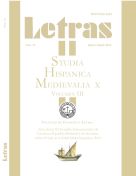Studies of the imperative in the medieval text of Cantigas de Santa Maria
Keywords:
Imperative Mood, Archaic Portuguese, Cantigas de Santa Maria, Verbal MorphologyAbstract
This study aims to map and analyze the morphological structure in the process of verb inflection of imperative forms in Archaic Portuguese (AP) in the Cantigas de Santa Maria (CSM). The methodology consists in mapping the imperative verb forms in the CSM. We have also used glossaries and vocabularies as a support in categorization of verb forms. After data is collected, the morphological structure of the imperative verb forms found are analyzed in comparison with the morphological structure of the simple present and Subjunctive mapped in the corpus, in order to explain if criteria such as order, presence or absence of the subject and contexts related to speech acts (order or request), can be used to consider whether a form is imperative or not. One hundred eighty-nine imperative verb forms conjugated in the second-person plural and second-person singular were collected and at the end of the analysis of the data we verified the high productivity of the suppression of the thematic vowel at an early stage of the language. We can prove that the imperative form preserved its morphological structure in the AP, since the variation indices start to emerge only in mid-eighteenth century, when there are the first manifestations of the process which replaces tu by você in treatment relations. We have also discussed, from a diachronic perspective, by the factors of linguistic and social nature that interfered and continue to interfere in the process of change in pronoun forms of address in BP and how this phenomenon is associated with the probable loss of the morphology of the imperative form. Thus, this thesis aims to contribute to the history of the Portuguese language.Downloads
References
ALI, S.M, 1964, Gramática Histórica da Língua Portuguesa, Brasília: UNB.
BAGNO, M. 2011, Gramática do português brasileiro, São Paulo: Parábola.
BLOOMFIELD, L. 1984 [1933], Language, Chicago: The University of Chicago Press.
CÂMARA JR., J. M., 1976, História e Estrutura da Língua Portuguesa, Rio de Janeiro: Vozes, 1ª ed. 1970.
————, 1964, Dicionário de filologia e gramática referente à língua portuguesa, 4 ed. Rio de Janeiro: J. Ozon.
CUNHA, C.F.; CINTRA, L.F.L., 1985, Gramática da Língua Portuguesa, Rio de Janeiro:Fename.
COUTINHO, I.L. de, 1958, Gramática Histórica, 4 ed., Rio de Janeiro: Livraria Acadêmica.
ERNOUT, A., 1945, Morphology Historique du Latin, Paris: C. Klincksieck.
FARACO, C.A., 1982, The imperative sentence in Portuguese: a semantic and historical discussion, University of Salford, Tese de doutorado.
FARIA, E., 1958, Gramática superior da Língua Latina, Rio de Janeiro: Livraria Acadêmica.
FERREIRA, M. P., 1994, The Stemma of the Marian Cantigas: Philogical and Musical Evidence. Bulletin of the Cantigueiros de Santa Maria, Cincinnati, n.6, p. 58-98.
FILGUEIRA VALVERDE, J., 1985, “Introducción”, en Alfonso X el Sabio, Cantigas de Santa María, Códice Rico de El Escorial, Madrid: Castalia. pp. XI-LXIII.
KEHDI, V., 2003, Morfemas do Português, São Paulo: Ática.
LEÃO, Â. V., 2002, Questões de linguagem nas Cantigas de Santa Maria, de Afonso X, Ensaios – Associação Internacional de Lusitanistas (AIL).
[http://www.pucrs.br/fale/pos/ail/leao01.htm] (acesso em 17.01.2005)
MAIA,C., 1997, História do Galego-Português, 2a edição, Coimbra: Fundação Calouste Gulbenkian/ Junta de Investigação Científica e Tecnológica. (Reimpressão da edição do INIC – 1986).
MENON, O. P da S., 1984, O imperativo no Português do Brasil, 1984, Dissertação de Mestrado em Letras, Universidade do Parané, Curitiba.
MATTOS E SILVA, R. V., 1989, Estruturas Trecentistas - elementos para uma gramática do Português Arcaico, Lisboa: Imprensa Nacional - Casa da Moeda.
————, 2001, O Português Arcaico: fonologia, São Paulo: Contexto.
MAURER JUNIOR, T.H., 1959, Gramática do latim vulgar, Rio de Janeiro: Livraria Acadêmica.
METTMANN, W., “Glossário”, em AFONSO X, O SÁBIO, Cantigas de Santa Maria, Coimbra: Universidade, 1972, v. IV: Glossário.
————, 1986b, “Introducción”, em ALFONSO X, EL SABIO, Cantigas de Santa María (cantigas 100), Madrid: Castalia, p. 7-42.
MONTEIRO, J.L., 2002, Morfologia Portuguesa, Campinas: Pontes.
PARKINSON, S., 1998, “As Cantigas de Santa Maria: estado das cuestións textuais”, em Anuario de estudios literarios galegos, Vigo, pp.179-205.
PENA, X.R., 1992, Literatura Galega Medieval, Santiago de Compostela, Gotelo Blanco.
PERINI, M.A., 1996, Gramática do Português Brasileiro, São Paulo, Parábola Editorial.
PONTES, E., 1972, Estrutura do verbo no português coloquial, Petrópolis, Vozes.
ROCHA, L. C. A. de, 1999, Estruturas morfológicas do Português, Belo Horizonte, Editora da UFMG.
ROSA, M.C., 2000, Introdução à morfologia, São Paulo, Contexto.
SCHERRE, M.M.P., 2002, “Uma reflexão sociolinguística sobre o conceito de erro”, em Bagno, M. Linguística da norma, São Paulo, Loyola.
SILVA NETO, S. da, 1952, História da Língua Portuguesa, 2a edição. Rio de Janeiro, Livros de
Portugal.
STAVROU, C., 1973, Portuguese pronouns and command forms, Hispanic American Association of Teachers of Spanish and Portuguese, p. 92-93.
VILELA, M.; Koch, I. V., 2001, Gramática da língua portuguesa: gramática da palavra, gramática da frase, gramática de texto, Coimbra: Livraria Almedina.
Downloads
Published
How to Cite
Issue
Section
License












